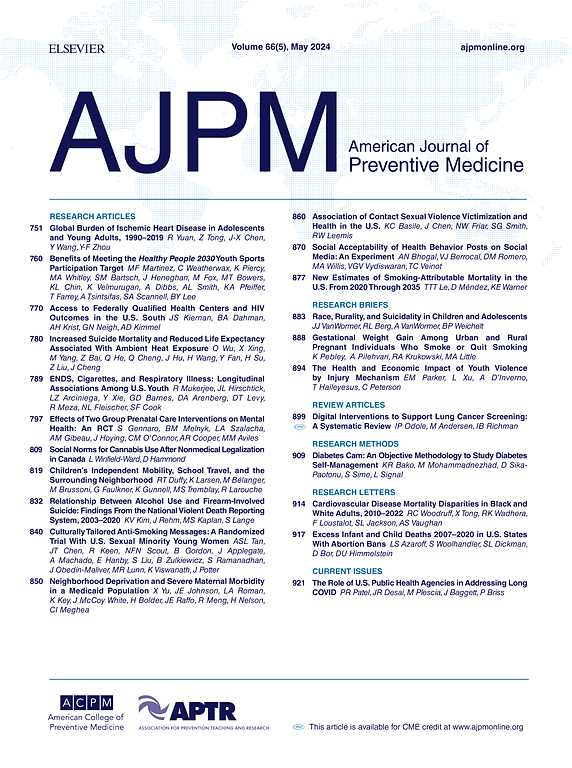A Multilevel Analysis of Social Environmental Factors Related to Substance Use, Tobacco Use, and Binge Drinking Behaviors Among Older Adults
IF 4.5
2区 医学
Q1 MEDICINE, GENERAL & INTERNAL
引用次数: 0
Abstract
Introduction
Social environmental factors are associated with risky health behaviors. However, limited research examines these relationships among older adults and across multiple levels of the social environment.
Methods
This study analyzed data from a 2021 survey of older adults (aged ≥50 years, n=2,774) in the mid-Atlantic region of the U.S. Using a socioecologic framework, the social environment was measured at the levels of the individual (loneliness, resilience, perceived discrimination), interpersonal (emotional social support), neighborhood (attraction to neighborhood, acts of neighboring, sense of belonging), and community (crime, area deprivation, racial residential segregation). Generalized structural equation models were used to examine the pathways from multilevel social environmental factors to risk behaviors (substance misuse, tobacco use, binge drinking), controlling for age, sex (male or female), race/ethnicity, marital status, educational level, household income, and metropolitan status. Analyses were conducted in 2024.
Results
Individual characteristics, including higher loneliness and discrimination and lower resilience, were associated with a higher likelihood of risk behaviors. Attraction to neighborhood, acts of neighboring, and sense of belonging were indirectly, negatively associated with risk behaviors through their relationships with individual characteristics and social support. However, acts of neighboring and sense of belonging were directly, positively associated with tobacco use and binge drinking. Racial segregation was indirectly, positively associated with risk behaviors through discrimination and neighborhood factors.
Conclusions
A multilevel approach is essential for understanding risk behaviors among older adults. Enhancing the built environment to improve neighborhood attractiveness and addressing structural factors that contribute to racial segregation could help reduce risk behaviors in this population.
与老年人物质使用、烟草使用和酗酒行为相关的社会环境因素的多水平分析。
社会环境因素与危险健康行为有关。然而,有限的研究考察了老年人之间的这些关系,并跨越了社会环境的多个层面。方法:本研究分析了2021年对美国大西洋中部地区老年人(50岁以上,n=2774)的调查数据。使用社会生态学框架,社会环境在个体(孤独、恢复力、感知歧视)、人际(情感社会支持)、邻里(邻里吸引力、邻里行为、归属感)和社区(犯罪、区域剥夺、种族居住隔离)的层面上进行测量。在控制了年龄、性别、种族/民族、婚姻状况、受教育程度、家庭收入和城市地位等因素的影响下,采用广义结构方程模型研究了多层次社会环境因素对危险行为(药物滥用、烟草使用、酗酒)的影响途径。分析于2024年进行。结果:个体特征,包括较高的孤独和歧视以及较低的适应能力,与较高的风险行为可能性相关。邻里吸引力、邻里行为和归属感通过与个体特征和社会支持的关系与风险行为呈间接负相关。然而,邻居行为和归属感与吸烟和酗酒直接呈正相关。种族隔离通过歧视和邻里因素间接与危险行为呈正相关。结论:多层次的方法对于理解老年人的危险行为至关重要。改善建筑环境,提高社区吸引力,解决导致种族隔离的结构性因素,有助于减少这一人群的风险行为。
本文章由计算机程序翻译,如有差异,请以英文原文为准。
求助全文
约1分钟内获得全文
求助全文
来源期刊

American Journal of Preventive Medicine
医学-公共卫生、环境卫生与职业卫生
CiteScore
8.60
自引率
1.80%
发文量
395
审稿时长
32 days
期刊介绍:
The American Journal of Preventive Medicine is the official journal of the American College of Preventive Medicine and the Association for Prevention Teaching and Research. It publishes articles in the areas of prevention research, teaching, practice and policy. Original research is published on interventions aimed at the prevention of chronic and acute disease and the promotion of individual and community health.
Of particular emphasis are papers that address the primary and secondary prevention of important clinical, behavioral and public health issues such as injury and violence, infectious disease, women''s health, smoking, sedentary behaviors and physical activity, nutrition, diabetes, obesity, and substance use disorders. Papers also address educational initiatives aimed at improving the ability of health professionals to provide effective clinical prevention and public health services. Papers on health services research pertinent to prevention and public health are also published. The journal also publishes official policy statements from the two co-sponsoring organizations, review articles, media reviews, and editorials. Finally, the journal periodically publishes supplements and special theme issues devoted to areas of current interest to the prevention community.
 求助内容:
求助内容: 应助结果提醒方式:
应助结果提醒方式:


